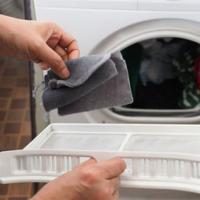How to Maintain the Lint Filter on a Clothes Dryer
by Guest Post on Nov 25, 2010
Running a household is a major responsibility, and to bear that responsibility you need to learn many new skills and talents. Beyond issues relating to proper parenting, keeping a positive atmosphere in the home, etc., which we won’t be discussing here, there are many things to be learned with regards to simply keeping the household moving forward without trouble.
As our homes are filled with household appliances, it becomes very important for you (as head of household) to know a good deal about how to maintain all those appliances—as the more you know about such matters, the less you will have to pay others to come in and maintain them for you. Regarding your clothes dryer, one extremely crucial yet nonetheless very simple chore regarding the maintenance of appliance parts is to clean the lint filter, and below we would like to briefly review this subject in order to help make a home living that much more bearable for our readers.
There’s a basic rule that you should follow regarding the use of your clothes dryer, and if you do so you will end up saving yourself a lot of worries as well as money, and you will furthermore reduce the risk of a fire in your home and will even help reduce your home’s carbon footprint. That rule is every time you go to use the dryer, make sure you have checked the lint filter and cleaned it. Preferably you should do this before each use of the dryer as that’s the best way to ensure that it is running at maximum efficiency for each cycle. Performing this task is really a piece of cake, as all dryers are manufactured to make it very simple and straightforward to access the filter, remove it, clean it, and then put it back in its place. Most typical clothes dryers have an internal lint filter, sometimes right in the area of the door and sometimes farther towards the back of the dryer; in almost all cases the filter is easy to remove and replace, needing only a little pressure to do so.
When you take out the lint filter you will be able to remove almost all of the lint by simply grabbing it and lifting away, as the lint fibers tend to mesh together and create a compact unit almost resembling a small rag. Though you can get rid of most of the lint with this simple procedure, it’s worth it to take one more tiny and quick precaution and to brush off the filter netting to remove tinier pieces of lint that are clogging the unit. To do so you need to remove the netting from the filter frame (in other cases you can’t disassemble in this manner, so you just brush the whole piece). Be sure to use a soft brush (such as a banister brush) as you don’t want to damage the filter at all, as that would defeat the purpose of this exercise; for that same reason, you should also check the netting for holes and replace it if you can see irregularities in the netting.
Popular Articles
Three Places to Spend Money on the Exterior of Your Home
When you have the exterior of your home remodeled, you are investing, time, energy and convenience into the project and you want to make sure that...
104908 Views
Homemade Headboards-Make an Upholstered or Wooden Headboard
Homemade headboards can add a lot of personality to any bedroom. They can be coordinated with existing furniture and room decor or they can be the...
80136 Views
When to Use a Brush, Roller or Sponge Brush
Brushes are a good choice for painting trim and woodwork. They are also useful for cutting in the edges around the top and bottom edges and corners...
72809 Views
Creating a Cottage Kitchen with Bead Board
Kitchen decor can range from modern and bold to elegant and elaborate by using strategic kitchen pieces. One of the most popular decorating trends...
58565 Views
Gas Fireplace Diagnostics and Troubleshooting
Follow these steps for diagnosing and troubleshooting Gas Fireplaces repairs. For the average DIYer, this may seem intimidating, depending on the...
35602 Views
Latest Articles
How Much Does it Cost to Take a Bath?
Plumbers know that a bath may seem like a relaxing luxury, but the real cost extends far beyond your water bill. The average soak uses 35 to 50...
on Apr 8, 2025
10 Concrete Patio Ideas on a Budget
A concrete patio can be a game-changer for your outdoor space. It is durable, versatile, and can be customized to fit your style. But what if you...
on Mar 25, 2025
Tips for Creating a Stunning Personalized Photo on Canvas
Order the unique beauty of a personalized photo on canvas and bring your memories to life. With a customized photo on canvas, you can transform...
on Mar 7, 2025
Best Areas to Buy Property in Singapore for Long-Term Growth
Singapore's real estate market remains one of the most stable and lucrative in the world. With limited land supply, strong governmental...
on Feb 18, 2025
Troubleshooting Excess Water in Your HVAC Secondary Condensate Drain Pan
When maintaining your air conditioning system, it is easy to overlook the condensate drain pan - until excess water starts pooling in places where...
on Jan 12, 2025
Featured Articles
What Type of Licensed Contractor Should You Hire?
on Feb 28, 2017
Hire Contractors / Estimates

Looking for a specialty project? There are many types of contractors available for your home improvement needs. Finding the right type of...
Sponsored Articles
Best Areas to Buy Property in Singapore for Long-Term Growth
on Feb 18, 2025
Real Estate / Finance

Singapore's real estate market remains one of the most stable and lucrative in the world. With limited land supply, strong governmental...
Actions
Top Categories
- Garden / Landscaping / Patio — 264
- Kitchen / Bathrooms — 240
- Real Estate / Finance — 203
- Appliance / Repair — 186
- Interior Design / Decor — 184
- HVAC / Air Conditioning — 148
- Cleaning / Maintenance — 144
- Improvements / Remodeling — 131
- Plumbing / Basements — 118
- Floors / Tile / Hardwood — 116
- Doors / Garages — 113
- Safety / Security — 113
Articles Archive
More DIY Articles
6 Dangers of Not Receiving Needed House Foundation Repairs
Most of us have heard horror stories about foundation problems and the possibilities of the damage that your home can entail. It is no surprise...
How To Create a Spa-Like Atmosphere in Your Bathroom
If you are looking for a way to add a little luxury to your life, why not start in your own bathroom? Creating a spa-like bathroom in your home can...
Installation and Care of a Septic System
Septic tanks are small scale sewage treatment plants that are common in households who find laying a complete sewage system expensive. The tanks...
5 Tips for Refreshing Your Bathroom
The daily steam and moisture in your bathroom make it a breeding zone for mold and mildew, increasing the risk of respiratory illnesses and...
Mold Removal Tips: How to Successfully Remove Mold for Good
Mold is a fungus that enters your home or premises as simple tiny spores. When these spores get moisture, they start to grow and fully develop into...

